This article is dedicated to the memory of those who lost their lives aboard
the Steam Trawler Beathwood in September 1940.
Contents
- Early years
- Beathwood in the World War II context
- Aboard the Beathwood
- Newspaper reports
- Memorials
- Recollections
- Records of wartime events
- The wreck
- Sources
Early years
The steam trawler (ST) Beathwood (registration A 442) was built in 1912 by the Aberdeen shipbuilders Alexander Hall & Sons Limited3 for Stroud's Steam Fishing Company Limited, and was originally named Osbourne Stroud. Her dimensions were length 115 3⁄12 feet, beam 22 5⁄12 feet and depth 13 feet, and gross weight 209 tons.
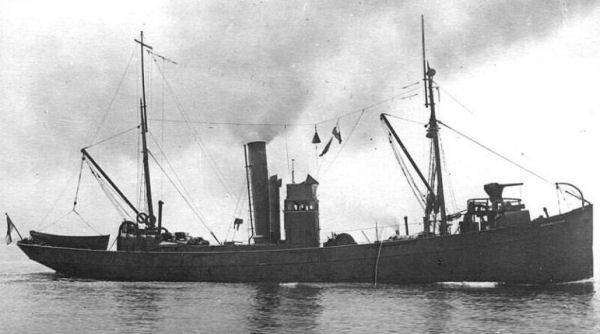
ST Osbourne Stroud, later renamed ST Beathwood
Entries in Lloyd's Register of Ships4 give her official number as 129377, built in March 1912 by A. Hall & Co. Ltd, Aberdeen, with a single deck. She had a triple-expansion three-cylinder steam engine with cylinders of diameters 11 5⁄8 inches, 20 inches and 33 inches, a stroke of 23 inches, registered 66 horsepower and also built by A. Hall & Co. Ltd, Aberdeen.
The ST Osbourne Stroud was purchased by the Admiralty in July 1914 for conversion to minesweeper. After the First World War, the Admiralty sold her to J R McBeath and others, and she was renamed Beathwood.
Lloyd's Register of Ships4 for 1934/35 to 1938/39 give her owners as "I.B. Wood & others (A.F. Wood, Mgr.)". She is also shown as having an echo sounding device (ESD).

Beathwood in the World War II context
The Second World War began in September 1939 following the German invasion of Poland. For much of Europe, the period September 1939 to April 1940 was the calm before the storm, and although there were some military actions, it became known as the "Phoney War".
The ST Beathwood was requisitioned by the Admiralty in December 1939 and designated as an armed patrol vessel. However, she was returned to her owners in 19403, and resumed fishing. Lloyd's Register of Ships4 for 1939/40 shows the following amendments to her ownership as " I.B. Wood & others (A.F. Wood, Mgr.) J. Grant T.W.N. Davidson". It therefore appears that she came under new ownership.
In April 1940, the war escalated with the rapid German invasion of Denmark and Norway, and then the invasions of the Netherlands, Belgium, Luxembourg and France. Between 27 May and 4 June 1940, 'Operation Dynamo' resulted in the evacuation of nearly 350,000 British, French, and allied troops from the beaches of Dunkirk. In the Battle of the Atlantic, German U-boats were an increasing threat to allied shipping with more than 350,000 tons being lost to U-boats in June.
The Battle of Britain began with the first great air-attack on England on 10 July 1940 in preparation for Hitler's 'Operation Sea Lion': the invasion of England. German air attacks on British convoys were also intensified. However, the Luftwaffe failed to achieve air superiority with the result that 'Operation Sea Lion' was postponed until 19-26 September. Marking a change of tactics, the "Blitzkrieg" began on 7 September, with intense bombing of London, which was later extended to other cities and to industry.
It is in this context that the British fishing fleet, including the ST Beathwood, continued its vital work to feed the nation.

Aboard the Beathwood
On the night of 11th September 1940, the Beathwood was near Montrose, on the east coast of Scotland. As one newspaper report described it, 'she was lying at anchor, completely blacked out, when at about 10 o'clock a German aircraft spotted it by the light of the moon. Most of the crew were below deck.'
As far as we can ascertain the crew of the Beathwood that night comprised:
| George Wood6 | Skipper | of Aberdeen (formerly of Cullen) | |
| William Findlay7 | Fisherman | ||
| William George Findlay8 | Cook | of Cullen, Banffshire | |
| Alexander Gardiner Mair | Mate | of Aberdeen (formerly of Cullen) | |
| Alexander Gardiner Mair (Jnr) 9 | Deckhand | of Aberdeen (formerly of Portsoy) | |
| John Milne10 | Second Engineer | of Aberdeen | |
| Alexander Pirie 11 | Deckhand | of Portknockie, Banffshire | |
| James Nichol Ruddiman12 | Chief Engineer | of Cullen, Banffshire |
Some reports indicated that there were nine crew and two survivors, so there may still be one further crewmember, yet to be identified, who also survived the attack.
The only man known to have survived is the Mate, Alexander Gardiner Mair, who lived to the age of 70.2
Over 3 weeks after the attack, the body of Alexander Pirie was discovered at Usan, near Montrose, and buried at Hillhead Cemetery, Portknockie.1 No others were recovered.

Newspaper reports
The newspaper reports that have been found contain no identification of the Beathwood and very little information about the attack due to wartime reporting restrictions. No reports were found in Montrose newspapers.









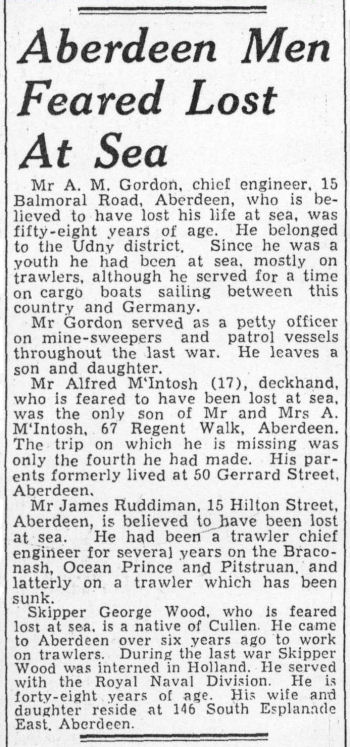
Mr A M Gordon and Mr A McIntosh mentioned in the above report were lost from the fishing vessel 'Flavia' on 28 August 1940.

THURSDAY, SEPTEMBER 19, 1940 16
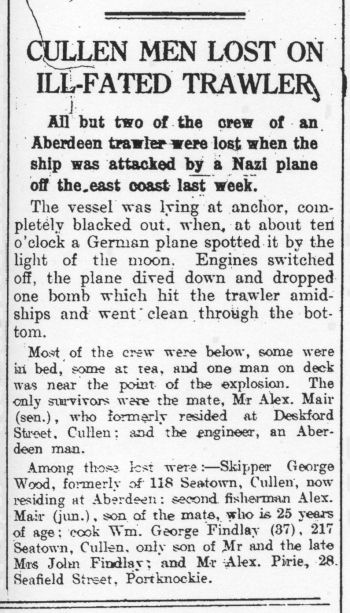
The above report mentions 2 survivors, as does the entry in 'Naval Events September 1940', reproduced below. A ninth member of the crew / second survivor has not yet been identified.


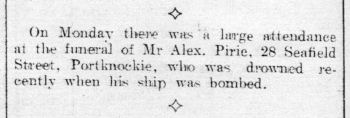

Memorials
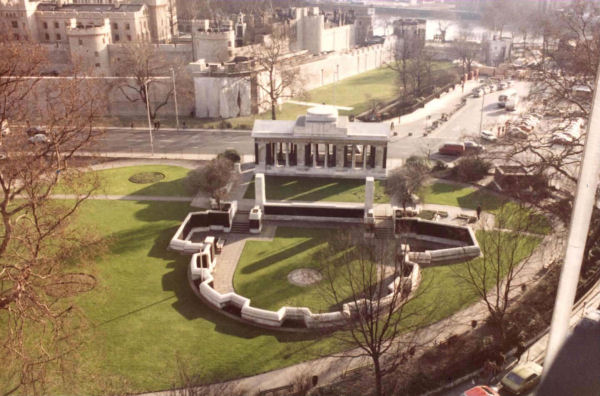
The Tower Hill Memorial in London commemorates
men and women of the Merchant Navy and Fishing Fleets
who died in both World Wars and who have no known grave.
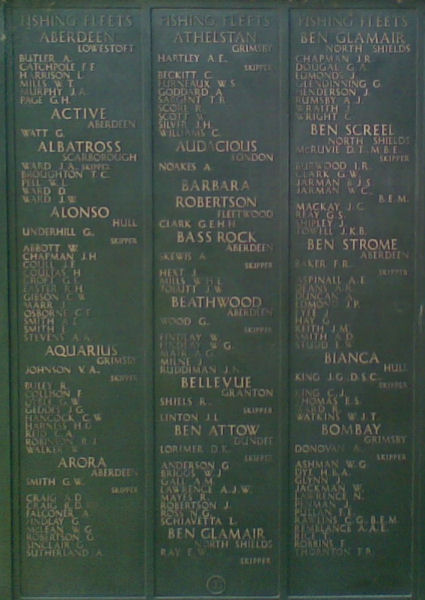
The Memorial to the crewmembers of the Steam Trawler Beathwood
who have no known grave is located in the centre section of Panel 123.
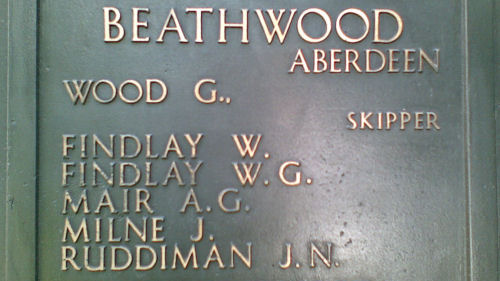

Recollections
Mike Mair's grandfather, Alexander Gardiner Mair, survived the attack, but his uncle, Alexander Gardiner Mair (Junior), perished. Mike's father, aged 5 at the time, recalled the following: 'My father said that he was in the wheelhouse, probably taking a night watch, when he heard an aeroplane flying around. He left the wheelhouse to come back aft to call down to the rest of the crew in the accommodation plus sleeping quarter that he heard an aeroplane around and they had better all come up. He was just started back on his way to the wheelhouse when there was a tremendous explosion and the ship immediately sank like a stone. My father was a non swimmer but he was right beside the wooden lifeboat and grabbed an oar which brought him to the surface and kept him afloat. When you know as I do that the only means of escape from the cramped accommodation was up a set of vertical steps about 8 or 10 feet high and through a narrow opening, you can imagine the panic of all these men trying to escape, probably in total darkness. My father said it was a beautiful calm clear moonlit night. He was picked up by another trawler because there were a few of them around. They circled the area for a long time looking for more survivors but eventually headed for Aberdeen where the Mission to Seamen gave him clothes and a taxi to come home in.' 2
Ian Pirie's father, Alexander Pirie, also perished. Ian was aged 11 at the time and recalled meeting a man at his father's funeral who had survived from the Beathwood, but whose son had been lost. He told Ian that the Beathwood had been hit by a torpedo dropped from a Dornier 17.1 That man would have been Alexander Gardiner Mair.

Records of wartime events
The 'Battle of Britain Campaign Diary', records that on the night of 11th September 1940 minelaying was suspected in the Thames Estuary, off the coasts of Northumberland and Aberdeenshire, off the Sussex Coast and South of the Isle of Man18.
The Chronik des Seekrieges19 (Chronicles of Naval Warfare), 1939-1945 at the Württembergische National Library at Stuttgart in Germany, contains the following:
|
6 - 28.9.1940 |
6th - 28th Sept. 1940 |
'British and Other Navies in World War 2 Day-by-Day: Naval Events September 1940', records that on Wednesday 11th September, the British steam trawler BEATHWOOD (209grt) was sunk by German bombing one mile east of Montrose Coast Guard Lookout20. Seven crew were lost on the trawler. There were two survivors. [Note: A ninth member of the crew / second survivor has not yet been identified.]
The Beathwood's final entry in Lloyd's Register of Ships4 was for 1940/41. Her owner was given as "T.W.N. Davidson" and a handwritten addition of "139/40" in the left hand margin probably relates to her loss.

The wreck
The RCAHMS Canmore database21 summarises details of surveys of the wreck of the Beathwood from several sources. The wreck has been designated NMRS Site Number NO75NE 8002, and is located at OS National Grid Reference NO 7518 5805. The locations of the wrecks of the steam trawler Beathwood and the steamship Clint are indicated on the map below.
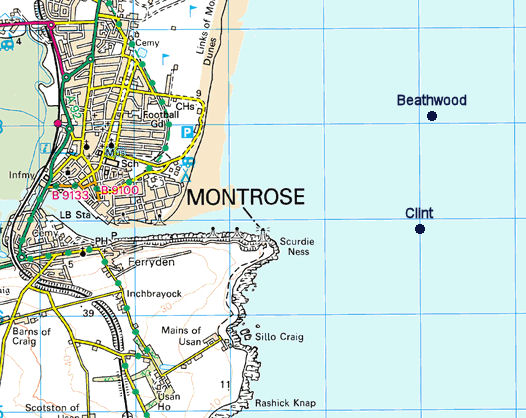
Reports of surveys undertaken include:
a 1954 report by a harbour pilot recording that the wreck of the Beathwood lies about 1⁄3 mile north east of the wreck of the steamship Clint;
a 1955 report of a survey by HMS Shackleton of the wreck at latitude 56 42 36N and longitude 002 24 18W. The least depth, measured by echosounder, was 16.7 metres in a general depth of 21.3 metres;
a 1989 report of a dive says that at radar ranges from a) Scurdie Ness 1.13 miles; b) Milton Ness 3.91 miles; the divers identified the stern section of a steel trawler [stern to boiler]. It gives the vessel's approximate length as 15 metres (49 feet), with a beam of 6 metres (19.6 feet). The highest part was the aft gallows, which have the least depth of 16 metres in a general depth of 18 metres.
The dive report would appear to indicate that the wreck of the Beathwood is not intact.
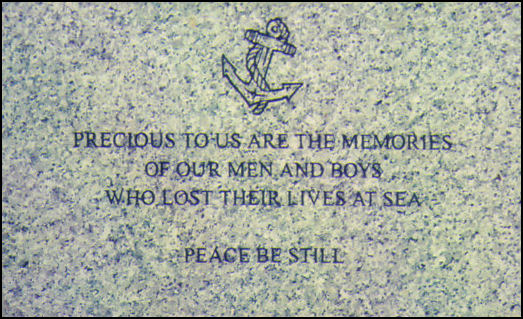
Neil A. Pirie, 2008/9

Sources
- Discussions with Ian Pirie, son of the Alexander Pirie and father of Neil Pirie, the author.
- Correspondence with Mike Mair of Calgary, Alberta, Canada, grandson of Alexander Mair and nephew of Alexander Gardiner Mair.
- Aberdeen Built Ships Project Website by the Aberdeen Maritime Museum.
- Plimsoll Ship Data Project Website by PortCities Southampton which has digitised pages from Lloyd's Register of Ships from 1930 to 1945. (Website currently offline.)
- CWGC Commonwealth War Graves Commission website.
- CWGC casualty details for George Wood.
- CWGC casualty details for William Findlay.
- CWGC casualty details for William George Findlay.
- CWGC casualty details for Alexander Gardiner Mair.
- CWGC casualty details for John Milne.
- CWGC casualty details for Alexander Pirie.
- CWGC casualty details for James Nichol Ruddiman.
- "Aberdeen Men Feared Lost at Sea", Press and Journal, Aberdeen, Friday, September 13, 1940, page 3.
- "Aberdeen Men Believed Lost At Sea", Evening Express, Aberdeen, Friday, September 13, 1940, page 3.
- "Aberdeen Men Feared Lost at Sea", Press and Journal, Aberdeen, Monday, September 16, 1940, page 3.
- "Cullen Men Lost on Ill-Fated Trawler", Banffshire Advertiser and Buckie and Moray Firth Gazette, Buckie, Thursday, September 19, 1940, Vol. LVIII, No 2978, page 5.
- "District Flashes", Funeral of Alexander Pirie, Banffshire Advertiser and Buckie and Moray Firth Gazette, Buckie, Thursday, October 10, 1940, page 5.
- Battle of Britain Campaign Diary Website by the Royal Air Force, 11th September 1940.
- "Chronik des Seekrieges" 1939-1945, Gewässer um Großbritannien, September 1940, Württembergische National Library, Stuttgart, Germany.
- British and Other Navies in World War 2 Day-by-Day by Don Kindell, Naval Events, September 1940, Part 1 of 2, Sunday 1st – Saturday 14th.
- The Royal Commission on the Ancient and Historical Monuments of Scotland (RCAHMS), Canmore database, Site Number NO75NE 8002, Beathwood, Montrose, North Sea.
- Translation kindly provided by Meredith Greiling, Assistant Keeper of Maritime History, Aberdeen Maritime Museum, Shiprow, Aberdeen, AB11 5BY, Scotland.
